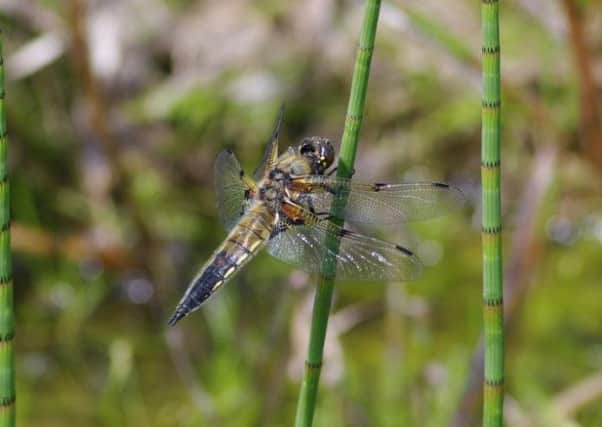Dragonflies ‘thriving’ in Scottish Highlands


Recent studies show two sites of special scientific interest near Loch Ness are among the top four areas in Scotland for spotting a wide range of the eye-catching creatures.
Surveys carried out by Forestry Commission Scotland (FCS) and Scottish Natural Heritage (SNH) show Glen Affric and Loch Bran are home to some of the UK’s most vulnerable species.
Advertisement
Hide AdAdvertisement
Hide AdTwo other hotspots for catching a glimpse of the winged insects are at Rothiemurchus and Loch Maree.
“Last summer’s survey has revealed these sites as top spots for these beautiful, colourful insects,” said Giles Brockman, environment manager for FCS’s Inverness, Ross & Skye team.
“The survey at Glen Affric found 12 species – with evidence that ten of them are breeding – but we know that as many as 15 species are here. So they’ve obviously benefited from the good weather we had last year.”
Getting conditions right for dragonflies and damselflies is an important part of the environment programme run by FCS and SNH in the area.
He added: “We do what we can to give these amazing insects a boost. Our work – and the great summer weather we had last year – seems to be exactly what the dragonflies need.”
The British Dragonfly Society (BDS) maintains a red list of endangered species. Of the four classed as vulnerable, three are known to exist in Glen Affric.
However, only one of these was recorded at the site in the latest count.
The endangered white-faced darter dragonfly can be seen there alongside the nationally important downy emerald. Both feature on the BDS list.
Advertisement
Hide AdAdvertisement
Hide AdCommon blue damselflies and common darter dragonflies have also been recorded in the glen but signs indicate they have not been producing offspring.
The Loch Bran study turned up fewer species, with just 10 being recorded. However the brilliant emerald dragonfly, listed as vulnerable, was recently found there.
Jonathan Willet, a surveyor for SNH, said: “Glen Affric was a superb area to survey for the variety of species found there.
“It is certainly one for the best sites to see dragonflies in the Highlands. Just about all of them can be seen from the footpath round Coire Loch, a popular circular walk in the nature reserve.
“Loch Bran is another fantastic site. It doesn’t have the same variety of species as Glen Affric but it is the most reliable site in the Highlands to see the brilliant emerald dragonfly.
“If you see this dragonfly with the sun illuminating its metallic green body, you will not forget it in a hurry.”
The vividly coloured insect had previously been sighted in Glen Affric but was not discovered there in 2013.
Dragonflies and damselflies lay their eggs in water and their larvae are aquatic. Two species, the azure hawker dragonfly and northern damselfly, are only found north of the border. Neither of these was discovered at the sites surveyed last year.
Advertisement
Hide AdAdvertisement
Hide AdThe azure hawker was first identified in the Highlands in 1845. It likes to bask in the sun early in the season and inhabits shallow pools with sphagnum moss.
It spends four to five years as an egg and then larva, before emerging as an adult. Though classed as vulnerable, there are some indications the species may be declining.
This distinctively marked dragonfly has been observed at Glen Affric in the past, though none was recorded in the latest research.
Seven other species found at Glen Affric in 2013 were the large red, blue-tailed and emerald damselflies as well as the common hawker, four-spotted chaser, golden-ringed, black darter and southern hawker dragonflies.
SEE ALSO: